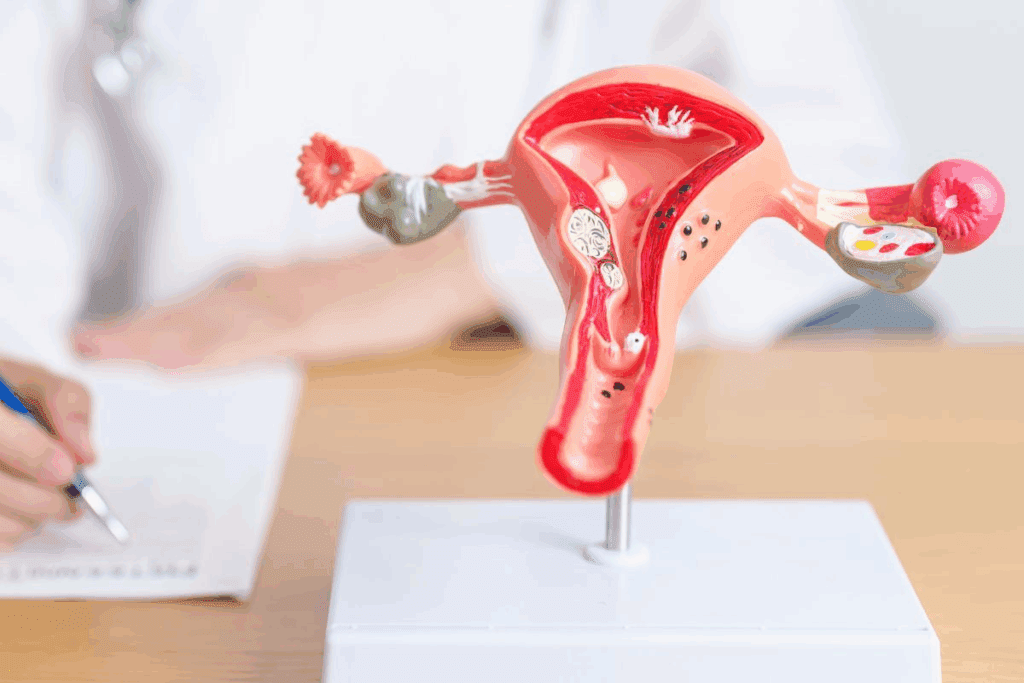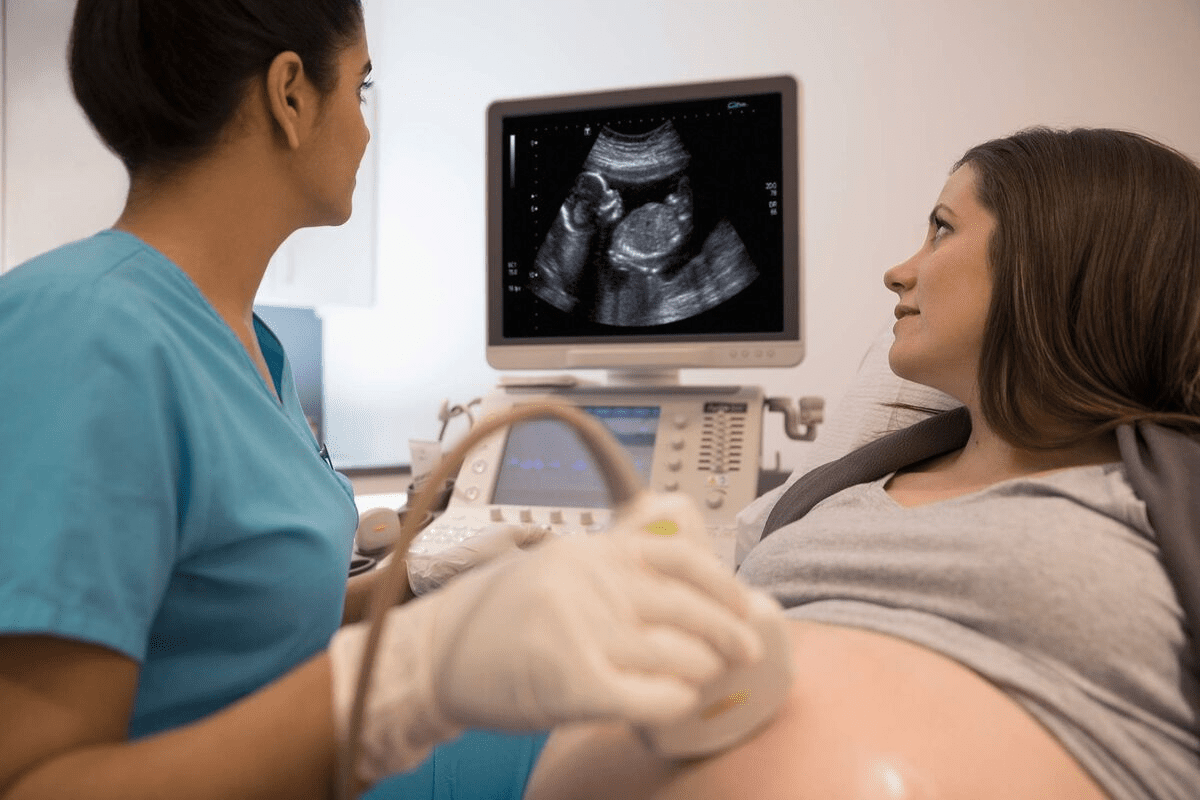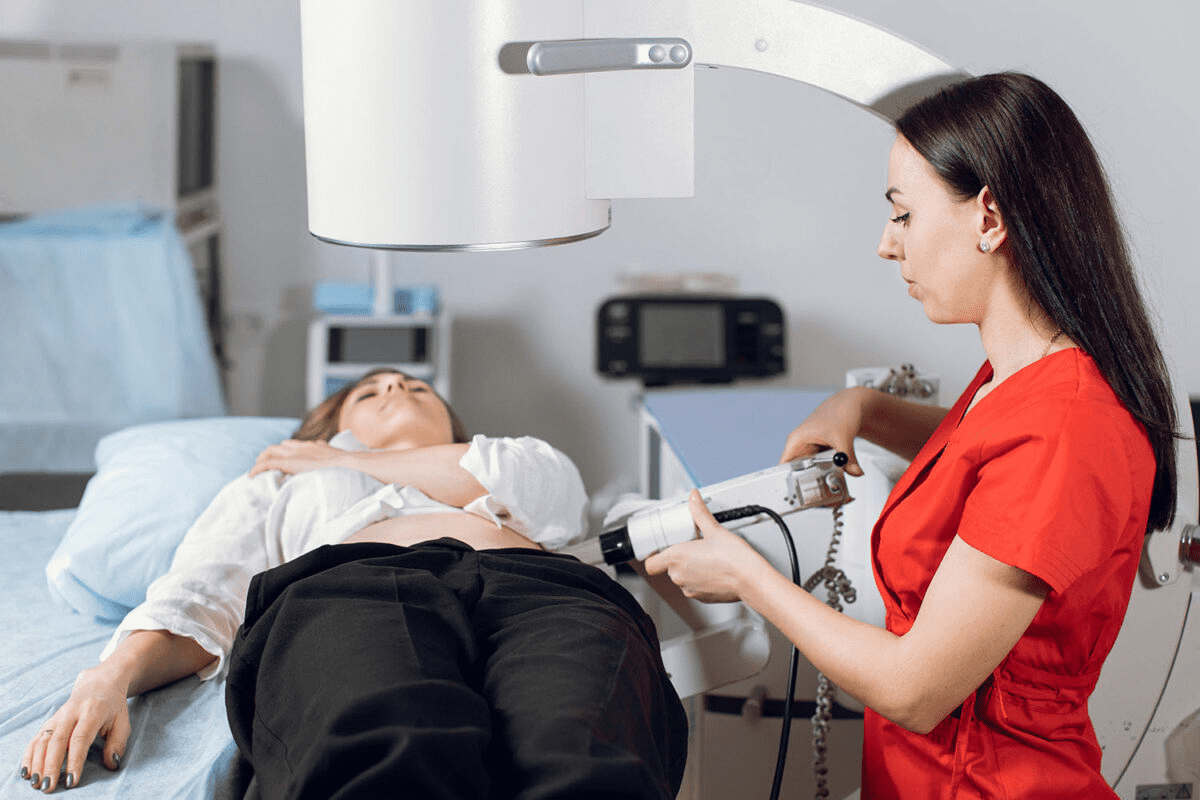Last Updated on November 26, 2025 by Bilal Hasdemir

Uterine fibroids are a common issue for many women around the world. For a long time, the main treatment was hysterectomy. But, new medical tech has brought minimally invasive techniques to help manage fibroids.Learn 5 powerful methods for fibroid shrink without a hysterectomy. Our 2025 guide covers the best non-surgical options.
Studies show that up to 80% of women with fibroids can get better without surgery. At Liv Hospital, we aim to give the safest and latest treatments. We focus on keeping fertility and improving life quality.
Key Takeaways
- Minimally invasive techniques are changing the landscape of fibroid management.
- Up to 80% of women with symptomatic fibroids are candidates for non-invasive treatments.
- Liv Hospital offers internationally trusted, patient-focused expertise in fibroid treatments.
- Alternative treatments to hysterectomy can preserve fertility and improve quality of life.
- Advanced medical technologies are reducing recovery time and improving patient outcomes.
Understanding Uterine Fibroids and Their Impact

Uterine fibroids are a common health issue affecting women worldwide. They cause a range of symptoms that can significantly impact daily life. These benign tumors can vary in size, number, and location within the uterus, leading to a variety of health concerns.
What Are Uterine Fibroids and Who Gets Them?
Uterine fibroids, also known as leiomyomas, are non-cancerous growths that develop in or around the uterus. They are quite common, affecting a significant portion of the female population at some point in their lives. Research indicates that fibroids can occur in women of reproductive age, with some studies suggesting that up to 80% of women may develop fibroids by the age of 50.
The exact cause of uterine fibroids is not fully understood, but factors such as genetics, hormones (estrogen and progesterone), and environmental influences are believed to play a role. Symptoms and growth rates can vary widely among affected women.
| Risk Factor | Description |
| Age | Risk increases with age, particularily in the 30s and 40s |
| Family History | Having a first-degree relative with fibroids increases risk |
| Ethnicity | Women of African descent are more likely to develop fibroids |
Symptoms and Quality of Life Concerns
The symptoms caused by uterine fibroids can be quite varied. They can significantly affect a woman’s quality of life. Common symptoms include:
- Heavy or prolonged menstrual bleeding
- Pelvic pain or pressure
- Frequent urination
- Constipation
- Infertility or recurrent miscarriage
These symptoms can lead to anemia, fatigue, and other complications. They can impact daily activities and overall well-being. Understanding the symptoms and their impact is key for seeking appropriate treatment.
When considering treatment options, it’s essential to understand that while hysterectomy has been a traditional approach for managing fibroids, many women now seek non-invasive fibroid treatments. These treatments aim to preserve the uterus and fertility. The good news is that various effective treatments are available. They offer hope for relief from symptoms without major surgery.
Why Women Seek Alternatives to Hysterectomy for Fibroid Tumors

Many women are looking for other ways to treat fibroid tumors instead of hysterectomy. They worry about how the surgery affects their health and ability to have children. This change is because hysterectomy is a big surgery with long-term effects.
Limitations of Hysterectomy Fibroid Surgery
Hysterectomy, or removing the uterus, is a common treatment for fibroids. But it has big downsides. It’s a major surgery that takes a long time to recover from. Women may feel a lot of pain and have trouble doing everyday things.
Also, hysterectomy means you can’t have children anymore. This is a big deal for many women who want to have kids in the future. The surgery also carries risks like infections and damage to other organs.
Some women also worry about the emotional impact of losing an organ linked to their femininity and reproductive health. This can be very hard for them.
The Importance of Uterine Preservation and Fertility
Keeping the uterus and being able to have children are key for many women. Treatments that remove or shrink fibroids but keep the uterus are more appealing. These options let women avoid the risks of hysterectomy and keep their ability to have kids.
Keeping the uterus is important for a woman’s identity and well-being. It has mental health benefits and lets women plan for future pregnancies. With new medical technology, there are more safe and less invasive treatments available. This gives women more choices that fit their health goals and personal wishes.
By looking into other options, women can make choices that balance treating fibroids with keeping their overall health and fertility in mind.
Uterine Fibroid Embolization (UFE): Leading Method to Fibroid Shrink
Uterine Fibroid Embolization (UFE) is a top choice for women wanting to avoid hysterectomy. It’s a minimally invasive treatment that shrinks fibroids and relieves symptoms. This improves life quality for many patients.
The Science Behind UFE
UFE cuts off blood to fibroids, causing them to shrink. This is done by injecting material into arteries that feed the fibroids. It reduces their size and impact on the uterus.
An interventional radiologist performs the procedure. They use imaging to guide a catheter to the uterine arteries. Then, they release embolic material to block blood flow to the fibroids.
The UFE Procedure Experience
The UFE procedure is usually done on an outpatient basis. Patients can go home the same day. It takes about 1-2 hours, with sedation to reduce discomfort.
Key aspects of the UFE experience include:
- Minimally invasive, reducing recovery time
- Performed under imaging guidance for precision
- Typically done under conscious sedation
- Quick return to normal activities
Recovery Timeline and Success Rates
Most women can get back to normal activities in a week or two. UFE’s success is seen in fibroid size reduction and symptom relief like heavy bleeding and pelvic pain.
Studies show:
- Up to 90% of women experience significant symptom relief
- Average fibroid volume reduction is around 40-50%
- Majority of patients report improved quality of life
UFE is a promising option for women wanting to avoid hysterectomy. It preserves uterine health while addressing fibroid issues.
MRI-Guided Focused Ultrasound (FUS): Precision Non-Invasive Fibroid Treatment
MRI-Guided Focused Ultrasound (FUS) has changed how we treat fibroids. It’s a non-surgical method that uses MRI and ultrasound. This combo treats fibroids without surgery.
Precision in Treatment: How FUS Technology Works
FUS uses sound waves to heat and destroy fibroids. It’s guided by MRI, which helps target fibroids without harming healthy tissue. This makes treatment safer and more effective.
The steps are:
- Detailed MRI imaging to locate and assess the fibroids.
- Planning the treatment area with precision.
- Delivery of focused ultrasound energy to the targeted fibroid tissue.
- Continuous monitoring of the treatment’s progress and temperature.
The Patient Experience During FUS Treatment
FUS is non-invasive, making it more comfortable for patients. Most treatments are done on an outpatient basis. Patients can go back to their daily activities quickly.
Key aspects of the experience include:
- Minimally invasive with no surgical incisions.
- Potential for same-day discharge.
- Reduced risk of complications compared to traditional surgical methods.
Effectiveness for Different Fibroid Types
FUS works well for many types of fibroids. It’s effective for fibroids that cause discomfort or health problems. The success depends on the fibroid’s size, location, and number.
Benefits for different fibroid types include:
- Effective for treating single or multiple fibroids.
- Can be used for fibroids of varying sizes.
- Precision targeting reduces the risk to surrounding tissues.
MRI-Guided Focused Ultrasound is a leading non-invasive treatment. It’s precise and preserves uterine health. This makes it a great option for many patients.
Transcervical Radiofrequency Ablation: Advanced Fibroid Removal Non-Invasive Option
Transcervical radiofrequency ablation is a new way to treat uterine fibroids. It’s a non-invasive method that’s getting a lot of attention. This treatment can shrink fibroids and ease symptoms without surgery.
The Technology Behind Radiofrequency Ablation
This method uses electrical energy to heat and destroy fibroid tissue. A special device is inserted through the cervix, guided by ultrasound. It emits radiofrequency energy to heat the fibroid, causing it to shrink and disappear.
The precision of transcervical radiofrequency ablation is key. It targets the fibroid without harming nearby healthy tissue. This helps keep the uterus healthy and can help women keep their fertility.
Procedure Details and Patient Experience
The procedure is usually done on an outpatient basis. This means patients can go home the same day. It starts with anesthesia to make sure patients are comfortable.
The procedure takes about 1-2 hours, depending on the fibroids. Patients often feel little pain during the procedure. Afterward, some may feel mild cramping or spotting, but these symptoms don’t last long.
Recovery and Long-Term Outcomes
Recovery from this treatment is quick. Most women can go back to their normal activities in a few days. Studies show that it can significantly reduce fibroid size and symptoms.
The non-invasive nature of this treatment makes it appealing to many. It’s effective and avoids the need for invasive surgery. But, it’s important to talk to a healthcare provider about your specific situation and what to expect.
Hormonal Therapy: Does Myfembree Shrink Fibroids?
Hormonal therapy is a big deal in treating uterine fibroids. Myfembree is getting a lot of attention for its benefits. It’s important to know how hormonal therapy works for fibroids.
Understanding GnRH Antagonists and Other Hormonal Approaches
GnRH antagonists, like Myfembree, are a type of hormonal therapy. They have shown promise in treating fibroids. These drugs affect hormone levels, which can slow down fibroid growth.
Other hormonal treatments include estrogen-progestin contraceptives and progestin-only therapies. They help manage fibroid symptoms. But, they don’t always shrink fibroids.
Myfembree: Mechanism of Action and Effectiveness
Myfembree combines a GnRH antagonist with an add-back hormone. It lowers estrogen levels to slow fibroid growth. It also includes hormones to prevent side effects.
Studies show Myfembree can reduce fibroid size and heavy bleeding. It’s easy to take because it’s a pill.
Limitations and Side Effect Considerations
Myfembree and other hormonal therapies have their limits and side effects. Common issues include hot flashes, night sweats, and mood swings.
Women thinking about hormonal therapy should talk to their doctor. It’s important to consider health, fertility goals, and symptom severity.
| Treatment Option | Mechanism of Action | Effectiveness in Shrinking Fibroids |
| Myfembree (GnRH antagonist + add-back therapy) | Reduces estrogen levels while providing low-dose hormone replacement | Clinically proven to reduce fibroid volume and improve symptoms |
| Estrogen-progestin contraceptives | Regulates hormonal balance to manage symptoms | Variable effectiveness in shrinking fibroids; mainly used for symptom relief |
| Progestin-only therapies | Influences hormonal environment to potentially reduce fibroid growth | Works for some, but results vary |
In conclusion, hormonal therapy, including Myfembree, is a good option for fibroids. Knowing how these treatments work helps women make informed choices.
Myomectomy: Surgical Fibroid Removal While Preserving the Uterus
Myomectomy is a surgery that removes uterine fibroids but keeps the uterus. This is great for women who want to have kids or are in their childbearing years. It helps them keep their fertility.
Types of Myomectomy Procedures
There are different myomectomy procedures, each with its own benefits. The right one depends on the fibroids’ size, number, and location. It also depends on the patient’s health and what they prefer.
- Abdominal Myomectomy: This traditional surgery makes a big incision in the belly to reach the uterus. It’s used for big fibroids or when there are many.
- Laparoscopic Myomectomy: This is a less invasive surgery with small cuts. A laparoscope is used to remove the fibroids. It leads to quicker healing.
- Hysteroscopic Myomectomy: This method removes fibroids through the vagina with a hysteroscope. It’s best for fibroids near the cervix.
- Robotic Myomectomy: This is a laparoscopic surgery with robotic help. It offers better precision and flexibility.
Recovery and Fertility After Myomectomy
Recovery from myomectomy varies by procedure. Most people feel some pain, which is managed with medicine. Recovery times range from a few weeks for small surgeries to 4-6 weeks for bigger ones.
Fertility after myomectomy is a big concern for many. Studies show it can help by removing fibroids that block conception or pregnancy. But, how it affects fertility depends on the fibroids’ size and location, and the woman’s age and health.
Women should talk to their doctor about their fertility goals before myomectomy. This makes sure the surgery fits their reproductive plans and increases the chance of success.
Choosing the Best Fibroid Treatment: Decision Factors to Fibroid Avoid Hysterectomy
Choosing the right fibroid treatment is important. You need to think about the fibroids’ characteristics. It’s key to consider your own situation and what you prefer.
Fibroid Characteristics: Size, Number, and Location
The size, number, and where fibroids are located matter a lot. Large fibroids might need more serious treatments. Smaller ones could be treated with less invasive methods.
Having many fibroids means you might need a more detailed treatment plan. Also, where in the uterus the fibroids are can affect the treatment choice. Some places are easier to treat than others.
Fertility Preservation Considerations
For women who want to have kids, keeping fertility in mind is very important. Treatments like myomectomy and Uterine Fibroid Embolization (UFE) are good because they try to keep the uterus and fertility. It’s important to talk about your fertility goals with your doctor to find the best treatment.
Recovery Time and Return to Normal Activities
How long it takes to recover and when you can go back to normal activities varies. Procedures like Transcervical Radiofrequency Ablation usually have shorter recovery times. Knowing how long you’ll need to rest is important for planning.
By looking at these factors and talking to your doctor, you can make a good choice for your fibroid treatment. This way, you can avoid needing a hysterectomy.
Conclusion: The Future of Uterine Fibroids Alternative Treatment
The way we treat uterine fibroids is changing. Now, we focus more on non-invasive and less invasive methods. This shift includes new technologies like Uterine Fibroid Embolization (UFE) and MRI-Guided Focused Ultrasound (FUS).
These advancements mean women have more choices. They can now find treatments that help them keep their fertility and recover quickly. This is a big step forward.
Looking ahead, the field of fibroid treatment is set to grow even more. New research and technologies are on the horizon. This means more options for women who don’t want a hysterectomy.
Healthcare providers are ready to adapt to these changes. They can now offer care that fits each woman’s needs. This will improve the lives of many women with uterine fibroids.
FAQ
What are uterine fibroids, and how common are they?
Uterine fibroids are non-cancerous growths in or around the uterus. They are very common, affecting many women, mostly during their reproductive years.
What are the symptoms of uterine fibroids, and how do they impact quality of life?
Symptoms include heavy menstrual bleeding and prolonged periods. They also cause pelvic pain or pressure and fertility issues. These symptoms can greatly affect a woman’s daily life and well-being.
Why are women seeking alternatives to hysterectomy for fibroid treatment?
Women want to keep their fertility and uterine health. Hysterectomy is a major surgery that removes the uterus. It’s a big decision, as it affects future childbearing.
How does Uterine Fibroid Embolization (UFE) work, and what can I expect during the procedure?
UFE cuts off the blood supply to fibroids, causing them to shrink. It’s done under local anesthesia. Patients usually go home the same day.
What is MRI-Guided Focused Ultrasound (FUS), and how effective is it for treating fibroids?
FUS uses sound waves to heat and destroy fibroid tissue. It’s guided by MRI for precision. It’s effective for treating various fibroids, with success rates based on size and location.
Does Myfembree shrink fibroids, and how does it work?
Myfembree is a hormonal therapy that can shrink fibroids. It lowers estrogen levels, which helps reduce fibroid growth. This can alleviate symptoms and shrink fibroids.
What is myomectomy, and how does it preserve fertility?
Myomectomy removes fibroids while keeping the uterus intact. This preserves fertility, allowing women to potentially get pregnant after surgery.
What factors influence the choice of fibroid treatment, and how can I make an informed decision?
Factors like fibroid size, number, and location matter. So do individual fertility goals and preferences. Talking to a healthcare provider about these can help choose the best treatment.
Are there non-invasive fibroid treatment options available?
Yes, options like UFE, FUS, and transcervical radiofrequency ablation are available. They offer alternatives to traditional surgery, with less recovery time and fewer complications.
Can fibroids be cured, or are they a recurring condition?
Fibroids can be treated and managed, but they might come back. Treatments like UFE, FUS, and myomectomy can provide long-term relief. But, ongoing monitoring is needed to address any future growth.
How long does it take to recover from fibroid treatment, and when can I return to normal activities?
Recovery time varies by treatment. UFE and FUS have shorter recovery times, often allowing a return to normal activities within a few days to a week. Myomectomy may require longer recovery periods.
References
Shrestha, O., Basukala, S., Thapa, N., et al. (2023). Endovenous laser ablation versus conventional surgery (ligation and stripping) for primary great saphenous varicose vein: A systematic review and meta-analysis. Annals of Medicine and Surgery, 85, 4509-4519. https://pubmed.ncbi.nlm.nih.gov/37663729/






